(Prototype team page) |
|||
| (9 intermediate revisions by 2 users not shown) | |||
| Line 1: | Line 1: | ||
| − | {{NCKU_Tainan | + | <html><head> |
| − | < | + | <meta charset="utf-8"><link rel="shortcut icon" href="/wiki/images/8/80/T--NCKU_Tainan--favicon.png" type="image/x-icon"><link rel="icon" type="image/png" href="/wiki/images/8/80/T--NCKU_Tainan--favicon.png"><link rel="icon" type="image/x-icon" href="/wiki/images/8/80/T--NCKU_Tainan--favicon.png"><meta name="viewport" content="width=device-width, initial-scale=1.0"><meta property="og:title" content="Project Results - iGEM NCKU"><meta property="og:site_name" content="Project Results - iGEM NCKU"><meta property="og:description" content=""><title>Project Results - iGEM NCKU</title><meta http-equiv="Content-Type" content="text/html" charset="utf-8"><meta property="og:image" content=""><meta property="og:image:type" content="image/png"><link rel="stylesheet" href="/Team:NCKU_Tainan/css/frame/T--NCKU_Tainan--bootstrap_min_css?ctype=text/css&action=raw"><link href="/Team:NCKU_Tainan/font/T--NCKU_Tainan--NotoSans_css?ctype=text/css&action=raw" rel="stylesheet" type="text/css"><link rel="stylesheet" href="/Team:NCKU_Tainan/font/T--NCKU_Tainan--font-awesome_min_css?ctype=text/css&action=raw"> <link rel="stylesheet" href="/Team:NCKU_Tainan/css/T--NCKU_Tainan--Layout_css?ctype=text/css&action=raw"> |
| + | </head> | ||
| + | <body> | ||
| + | <style>@font-face { font-family: 'NotoSansCJKtc-Regular'; src: url("/wiki/images/0/0b/T--NCKU_Tainan--NotoSansCJKtc-Regular.woff") format('woff');}</style><nav class="navbar navbar-default"><div id="navbar-container" class="container-fluid"> <div class="navbar-header"> <button type="button" class="navbar-toggle collapsed" data-toggle="collapse" data-target="#navbar" aria-expanded="false"> <span class="sr-only">Toggle navigation</span> <span class="icon-bar"></span> <span class="icon-bar"></span> <span class="icon-bar"></span> </button> <a class="navbar-brand" href="/Team:NCKU_Tainan"> <h1>NCKU</h1><h4>Tainan</h4> </a> </div> <div id="navbar" class="navbar-collapse collapse"> <ul class="nav navbar-nav"> <li> <a class="dropdown-toggle" type="button" id="dropdownMenu1" data-toggle="dropdown" aria-haspopup="true" aria-expa="" nded="true" href="">Project</a><div class="nav-underline"></div> <ul class="dropdown-menu" aria-labelledby="dropdownMenu2"> <li><a href="/Team:NCKU_Tainan/Project">Background</a></li> <li><a href="/Team:NCKU_Tainan/Description">Description</a></li> <li><a href="/Team:NCKU_Tainan/Results">Results</a></li> <li><a href="/Team:NCKU_Tainan/Model">Modeling</a></li> <li><a href="/Team:NCKU_Tainan/Parts">Parts</a></li> </ul> </li> <li> <a class="dropdown-toggle" type="button" id="dropdownMenu2" data-toggle="dropdown" aria-haspopup="true" aria-expa="" nded="true" href="">Device</a><div class="nav-underline"></div> <ul class="dropdown-menu" aria-labelledby="dropdownMenu2"> <li><a href="/Team:NCKU_Tainan/Hardware">Hardware</a></li> <li><a href="/Team:NCKU_Tainan/Software">Software</a></li> <li><a href="/Team:NCKU_Tainan/Demonstrate">Demonstrate</a></li> </ul> </li> <li> <a class="dropdown-toggle" type="button" id="dropdownMenu3" data-toggle="dropdown" aria-haspopup="true" aria-expa="" nded="true" href="">Judging</a><div class="nav-underline"></div> <ul class="dropdown-menu" aria-labelledby="dropdownMenu3"> <li><a href="/Team:NCKU_Tainan/Medal">Medal</a></li> <li><a href="/Team:NCKU_Tainan/Safety">Safety</a></li> </ul> </li> <li> <a class="dropdown-toggle" type="button" id="dropdownMenu4" data-toggle="dropdown" aria-haspopup="true" aria-expa="" nded="true" href="/Team:NCKU_Tainan/Team">Team</a><div class="nav-underline"></div> <ul class="dropdown-menu" aria-labelledby="dropdownMenu4"> <li><a href="/Team:NCKU_Tainan/Team">Team</a></li> <li><a href="/Team:NCKU_Tainan/Attributions">Attributions</a></li> <li><a href="/Team:NCKU_Tainan/Acknowledgement">Acknowledgement</a></li> <li><a href="/Team:NCKU_Tainan/Collaborations">Collaborations</a></li> </ul> </li> <li> <a class="dropdown-toggle" type="button" id="dropdownMenu5" data-toggle="dropdown" aria-haspopup="true" aria-expa="" nded="true" href="/Team:NCKU_Tainan/Human_Practices">Human Practices</a><div class="nav-underline"></div> <ul class="dropdown-menu" aria-labelledby="dropdownMenu5"> <li><a href="/Team:NCKU_Tainan/Human_Practices">Overview</a></li> <li><a href="/Team:NCKU_Tainan/Integrated_Practices">Integrated Practices</a></li> <li><a href="/Team:NCKU_Tainan/Engagement">Engagement</a></li> </ul> </li> <li> <a class="dropdown-toggle" type="button" id="dropdownMenu6" data-toggle="dropdown" aria-haspopup="true" aria-expa="" nded="true" href="">Notebook</a><div class="nav-underline"></div> <ul class="dropdown-menu" aria-labelledby="dropdownMenu6"> <li><a href="/Team:NCKU_Tainan/Notebook_Construction">Construction</a></li> <li><a href="/Team:NCKU_Tainan/Notebook_Functional_Test">Functional Test</a></li> <li><a href="/Team:NCKU_Tainan/Notebook_Device_Design">Device Design</a></li> <li><a href="/Team:NCKU_Tainan/Notebook_Protocols">Protocols</a></li> <li><a href="/Team:NCKU_Tainan/Notebook_Model">Model</a></li> </ul> </li> </ul> <ul class="nav navbar-nav navbar-right"> </ul> </div><!--/.nav-collapse --></div><!--/.container-fluid --></nav><div id="container-big"><div id="iGEMbar"></div><div id="line-left"></div><div id="line-left2"></div><div id="line-right"></div><div id="photo-left"></div></div><!--/.container-big --> <style> | ||
| + | #photo-left { background-image: url("/wiki/images/6/6f/T--NCKU_Tainan--Results.png"); } | ||
| + | </style> | ||
| + | <div class="container-fluid" style="margin-top:100px"> | ||
| + | <div class="head">PROJECT / Results</div> | ||
| + | <div class="content row"> | ||
| + | <div class="col-md-9"> | ||
| + | <h2 class="head2">Result / Proof of concept</h2> | ||
| + | <div class="title-line long" id="Achiment"></div> | ||
| + | <div class="title-content">U-KNOW Achievement</div> | ||
| + | <div class="phighlight"> | ||
| + | <p>1. We constructed and submitted our Detection circuit and Safety circuit that serve as a glucose sensor and function the suicide system.</p> | ||
| + | <p>2. We successfully differentiated diabetic urine samples with control, supported by a <a href="/Team:NCKU_Tainan/Model_Statistics_Analysis">statistical significance</a> and 95~100% sensitivity. | ||
| + | </p><p>3. We characterized the relation between the glucose concentration and RFP fluorescent intensity;<br> | ||
| + | Furthermore, the <a href="/Team:NCKU_Tainan/Model_Fitting_Theory">prediction formula</a> to quantify the amount of glucose in a urine glucose level was derived. | ||
| + | </p><p>4. We validated our bio-safety <a href="#safety" onclick="return toEvent('safety');">suicide system.</a></p> | ||
| + | <p>5. We created <a href="/Team:NCKU_Tainan/Hardware">well-designed prototypes</a> to function our U. coli working in a real world.</p> | ||
| + | </div> | ||
| + | <div class="title-line" id="Detect">Glucose Detection</div> | ||
| − | < | + | <h5>Experiment Design</h5> |
| + | <p>The goals for our Detection circuit are to detect and indicate the presence of urine glucose with promoter PI. To measure the precise level of urine glucose, we need to look at the fluorescent intensity of mRFP.</p> | ||
| − | < | + | <img src="/wiki/images/e/ea/T--NCKU_Tainan--image000.png" alt="fig1"> |
| − | < | + | <p><b>Figure 1:</b> We induced our U. coli detection circuit with urine samples containing different glucose level and measured the fluorescent intensity kinetically at different timepoints.</p> |
| − | < | + | |
| − | + | ||
| − | + | ||
| − | + | ||
| − | + | ||
| − | </ | + | <h5>Characterization of glucose induced mRFP expression</h5> |
| + | <p>Within the preliminary test, we induced our U. coli for 12 hours to function our Detection circuit. The glucose concentrations are 0, 5, 15, 30, 60 mM.</p> | ||
| − | < | + | <img src="/wiki/images/9/91/T--NCKU_Tainan--image001.png" alt="fig2 result: PI_RBS_mRFP_TT"> |
| + | <p><b>Figure 2:</b> PI_RBS_mRFP_TT transformed in <i>E. coli</i> BL21 (DE3). After 12-hour induction with final glucose concentration of: 0, 5, 15, 30, 60 mM, the fluorescence was observed under excitation ray of 470 nm and with the filter “LEE filter 019”</p> | ||
| + | <p>To further quantify the fluorescent intensity, and simultaneously the growth curve of U. coli, we used final glucose concentration of: 0, 5, 15, 30 mM to induce our U. coli for 8 hours with total volume of 20 ml, and measured the fluorescent intensity at excitation/emission wavelength 562 nm / 599 nm and OD<sub>600</sub> for growth curve.</p> | ||
| − | < | + | <figure style="width:49%;display:inline-block;"> |
| + | <img src="/wiki/images/2/21/T--NCKU_Tainan--image002.png" alt="fig3 result"> | ||
| + | <figcaption>(a)<figcaption> | ||
| + | </figcaption></figcaption></figure> | ||
| + | <figure style="width:49%;display:inline-block;"> | ||
| + | <img src="/wiki/images/4/48/T--NCKU_Tainan--image003.png" alt="fig3 result"> | ||
| + | <figcaption>(b)<figcaption> | ||
| + | </figcaption></figcaption></figure> | ||
| − | <p> | + | <p><b>Figure 3:</b> Above is the growth curve and fluorescent intensity, the experiments were done in <i>E. coli</i> BL21-(DE3) in modified M9 medium, the cell were cultured in modified M9 medium for 2 hours and glucose of final concentration: 0, 5, 15, 30 mM were add to induce the expression of mRFP. The fluorescent intensity were measured every 2 hours, after total time exceeds 10 hours, experiments with 5, 15, 30 mM glucose has 2~4 fold significant difference (P<0.05, student t-test)of induction compared to control (0 mM). The presence of glucose also affects the growth curve of our U. coli compared to control, but the growth curves of 5, 15, 30 mM does not show significant difference.</p> |
| − | < | + | <h5>Proof of Concept: Differentiating diabetic urine with normal</h5> |
| − | + | <p>To proof that our U. coli serves the purpose to differentiate between diabetic and normal urine samples, we calculated the average prediction interval for the fluorescent intensity in the four different glucose concentrations. The upper control limit is considered as the threshold of “positive”. When the fluorescent intensity in a urine sample surpasses the upper control limit, we can refer to the urine sample as diabetes urine. Furthermore, the diabetic test on U-KNOW has <b>sensitivity: 95% and specificity: 100%</b>.</p> | |
| − | < | + | |
| − | </ | + | |
| − | </ | + | <img src="/wiki/images/4/46/T--NCKU_Tainan--image004.png" alt="fig4 result"> |
| + | <p><b>Figure 4:</b> The 95% prediction interval of glucose positive (5 mM) urine sample (green) and glucose negative (0.1 mM) urine sample (red),the two intervals can be separated after T > 101 mins. To verify the function, by applying the upper limit of the 95% prediction interval of glucose negative urine sample (red) as the “diabetic threshold“, we performed a test to clarify whether our U. coli can differentiate diabetes from control. At time T = 101 mins with n = 84, our result shows sensitivity = 95% / specificity: 100% and if we delay the testing time to T = 120 mins, the sensitivity will be 100% (n=84), which proved that our U. coli could differentiate the diabetic urine from normal urine.</p> | ||
| + | <p>To further elaborate our proof of concept, we have a <a href="/Team:NCKU_Tainan/Model_Statistics_Analysis">statistical calculation</a>.</p> | ||
| − | < | + | <h5>Proof of Concept: Prediction and Quantifying the amount of urine glucose</h5> |
| + | <p>After successfully differentiating diabetic urine sample with control, we aimed to measure the amount of glucose in urine sample. Thus, we used final glucose concentration of: 0, 1, 3, 5, 15, 30, 45 mM to induce our U. coli for 12 hours in 96 well and measure the fluorescent intensity at excitation/emission wavelength 562 nm / 599 nm, the differences of fluorescent intensity between each group had statistical significance (P<0.05, student t-test) at T (time) = 8hr.</p> | ||
| − | < | + | <img src="/wiki/images/7/7f/T--NCKU_Tainan--image006.png" alt="fig5 result"> |
| − | + | <p><b>Figure 5:</b> Fluorescence intensity with 95% confidence interval after 8 hour induction with final glucose concentration 0, 1, 3, 5, 15, 30, 45 mM, all differences between each group shows statistical significance (P<0.05, student t-test), proving that out U. coli do differentiate urine sample containing various amount of glucose, ranging from 0~45 mM.</p> | |
| − | + | ||
| − | + | ||
| − | + | ||
| − | < | + | |
| − | + | ||
| − | </ | + | <p>Based on the results above, we derived a <a href="/Team:NCKU_Tainan/Model_Fitting_Theory">prediction formula</a>, to calculate the urine glucose concentration (C)</p> |
| + | <img src="/wiki/images/e/e9/T--NCKU_Tainan--image008.png" alt="fig6 result"> | ||
| + | <p><b>Figure 6:</b> $$\frac{d[GFP]}{dt}=\frac{18.65\times [Glucose]^{2.02}+38.25}{[Glucose]^{2.02}+5.07}$$</p> | ||
| + | <p>To verify the formula, we performed a test to clarify whether our U. coli can predict and quantify the concentration of urine glucose. </p> | ||
| + | <p>Reuslt: with n=63, the average recovery rate is 104% (95% ~114%), which proved that our U. coli do predict and quantify the concentration of urine glucose with good precision.</p> | ||
| − | </html> | + | <p>In conclusion, by applying this <a href="/Team:NCKU_Tainan/Model_Fitting_Theory">prediction formula</a>, it shown that our U. coli could predict and quantify the concentration of urine glucose.</p> |
| + | |||
| + | <div class="title-line long" id="safety"></div> | ||
| + | <div>Bio-Safety System</div> | ||
| + | |||
| + | <h5>Experiment Design</h5> | ||
| + | <p>The goal for our safety circuit is to protect our device user, and it is also an eco-environment tool. When our column-by-column reading device detects arabinose in the sample, the promoter P<sub>BAD</sub> is activated to lyse and kill the U. coli. Also, the efficacy of the safety circuit can be determined by measuring the growth curve and checking CFU (colony-forming units) assays.</p> | ||
| + | |||
| + | <img src="/wiki/images/c/c6/T--NCKU_Tainan--image005.png" alt="fig7"> | ||
| + | <p><b>Figure 7:</b> Schematic diagram of P<sub>BAD</sub> regulation in different concentration of glucose and arabinose.</p> | ||
| + | |||
| + | <h5>Growth Inhibition and Lysis activation</h5> | ||
| + | <p>Promoter P<sub>BAD</sub>, is activated by AcaC-arabinose dimers and repressed upon the presence of glucose (Table 1). When the downstream lysis gene is transcribed, the product, lysis proteins, can lyse and kill the U. coli. In the functional test of safety circuit, the growth of U. coli with 3 hour arabinose (10 mM) induction was inhibited, even with presence of glucose (Figure 8). Compared to the control group, arabinose significantly inhibited the growth of U. coli after 50 mins (time T>50 mins). In addition, when glucose and arabinose (10 mM) both present, glucose will repress the growth inhibitory effect of arabinose, making the U. coli continue to growth.</p> | ||
| + | |||
| + | <table> | ||
| + | <tbody><tr> | ||
| + | <th>Activation of P<sub>BAD</sub></th> | ||
| + | <th>High Arabinose</th> | ||
| + | <th>Low Arabinose</th> | ||
| + | </tr><tr> | ||
| + | <td style="font-weight:bold">High Glucose</td> | ||
| + | <td>Repressed (10 mM Ara) / Active (40 mM Ara)</td> | ||
| + | <td>Repressed</td> | ||
| + | </tr><tr> | ||
| + | <td style="font-weight:bold">Low Glucose</td> | ||
| + | <td>Active</td> | ||
| + | <td>Repressed</td> | ||
| + | </tr> | ||
| + | </tbody></table> | ||
| + | |||
| + | <p><b>Table 1:</b> Activation of promoter P<sub>BAD</sub> in different concentration of glucose and arabinose.</p> | ||
| + | |||
| + | <img src="/wiki/images/b/bd/T--NCKU_Tainan--image014.png" alt="fig8"> | ||
| + | <p><b>Figure 8:</b> U. coli, P<sub>BAD</sub>-RBS-lysis-TT transformed in <i>E. coli</i> BL21 (DE3), was incubated for 6 hr and transferred (1%) to modified M9 medium containing different concentrations of arabinose and glucose, and OD600 was measured kinetically by 96-well plate reader.</p> | ||
| + | |||
| + | <p>To understand whether the higher concentration of arabinose represses the glucose-inhibited activation of P<sub>BAD</sub>, we conducted the functional test. It demonstrated a decrease of the growth of U. coli with 2-hour arabinose (40 mM) induction (Figure 9). Meanwhile, the U. coli with arabinose induction showed considerable low CFUs indicating the induction of lysis gene expression triggers U. coli death (Figure 10).</p> | ||
| + | |||
| + | <img src="/wiki/images/4/4b/T--NCKU_Tainan--safety0.jpg" alt="fig9"> | ||
| + | <p><b>Figure 9:</b> Arabinose inhibited the growth of U. coli. The U. coli was incubated on 96-well plate at 37℃ in the ELISA reader. The signals of OD600 are examined per 3 minutes.</p> | ||
| + | |||
| + | <img src="/wiki/images/e/e6/T--NCKU_Tainan--image016.png" alt="fig10"> | ||
| + | <p><b>Figure 10:</b> Arabinose triggered the U. coli death. The markers of 4, 3, 2, and 1 in each quarter rounds of plate indicated the dilution of 103, 104, 105, and 106, respectively. Every quarter rounds in plate were plated 20 μl dilutions on LB-Amp plate and counted the CFUs after ~15 hrs of incubation at 37℃. The original cultures were from the Figure 1 experiment at 2 hrs.</p> | ||
| + | <p>These data show that the safety system can work as expected. Arabinose induce expression of the lysis gene (K117000), and then inhibit the <i>E. coli</i> growth and trigger the U. coli death.</p> | ||
| + | </div> | ||
| + | <div class="col-md-3"> | ||
| + | <ul id="sidemenu"> | ||
| + | <li><a href="#" onclick="return toEvent('Achiment');">U-KNOW Achievements</a></li> | ||
| + | <li><a href="#" onclick="return toEvent('Detect');">Glucose Detection</a></li> | ||
| + | <li><a href="#" onclick="return toEvent('safety');">Bio-Safety System</a></li> | ||
| + | </ul> | ||
| + | </div> | ||
| + | </div> | ||
| + | </div> <!-- /.container-fluid --> | ||
| + | <script src="/Team:NCKU_Tainan/js/frame/T--NCKU_Tainan--jquery-1_12_0_min_js?ctype=text/javascript&action=raw"></script><script src="/Team:NCKU_Tainan/js/frame/T--NCKU_Tainan--bootstrap_min_js?ctype=text/javascript&action=raw"></script><script src="/common/MathJax-2.5-latest/MathJax.js?config=TeX-AMS-MML_HTMLorMML"></script><script src="/Team:NCKU_Tainan/js/T--NCKU_Tainan--MathjaxConfigIgem_js?ctype=text/javascript&action=raw"></script><script src="/Team:NCKU_Tainan/js/T--NCKU_Tainan--common_js?ctype=text/javascript&action=raw"></script><script>(function() { /* change icon */ var link = document.createElement('link'); link.type = 'image/x-icon'; link.rel = 'shortcut icon'; link.href = '/wiki/images/8/80/T--NCKU_Tainan--favicon.png'; document.getElementsByTagName('head')[0].appendChild(link);}());</script> | ||
| + | |||
| + | </body></html> | ||
Latest revision as of 16:11, 19 October 2016
Result / Proof of concept
1. We constructed and submitted our Detection circuit and Safety circuit that serve as a glucose sensor and function the suicide system.
2. We successfully differentiated diabetic urine samples with control, supported by a statistical significance and 95~100% sensitivity.
3. We characterized the relation between the glucose concentration and RFP fluorescent intensity;
Furthermore, the prediction formula to quantify the amount of glucose in a urine glucose level was derived.
4. We validated our bio-safety suicide system.
5. We created well-designed prototypes to function our U. coli working in a real world.
Experiment Design
The goals for our Detection circuit are to detect and indicate the presence of urine glucose with promoter PI. To measure the precise level of urine glucose, we need to look at the fluorescent intensity of mRFP.
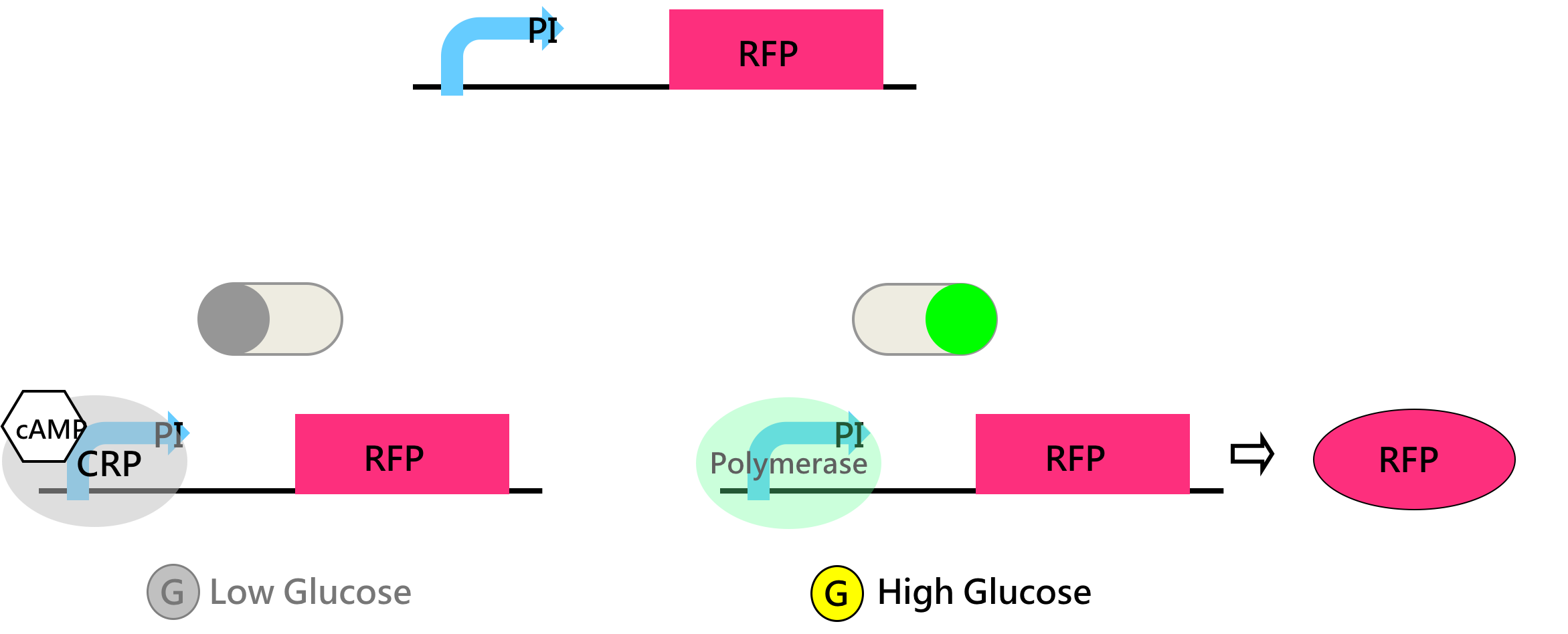
Figure 1: We induced our U. coli detection circuit with urine samples containing different glucose level and measured the fluorescent intensity kinetically at different timepoints.
Characterization of glucose induced mRFP expression
Within the preliminary test, we induced our U. coli for 12 hours to function our Detection circuit. The glucose concentrations are 0, 5, 15, 30, 60 mM.
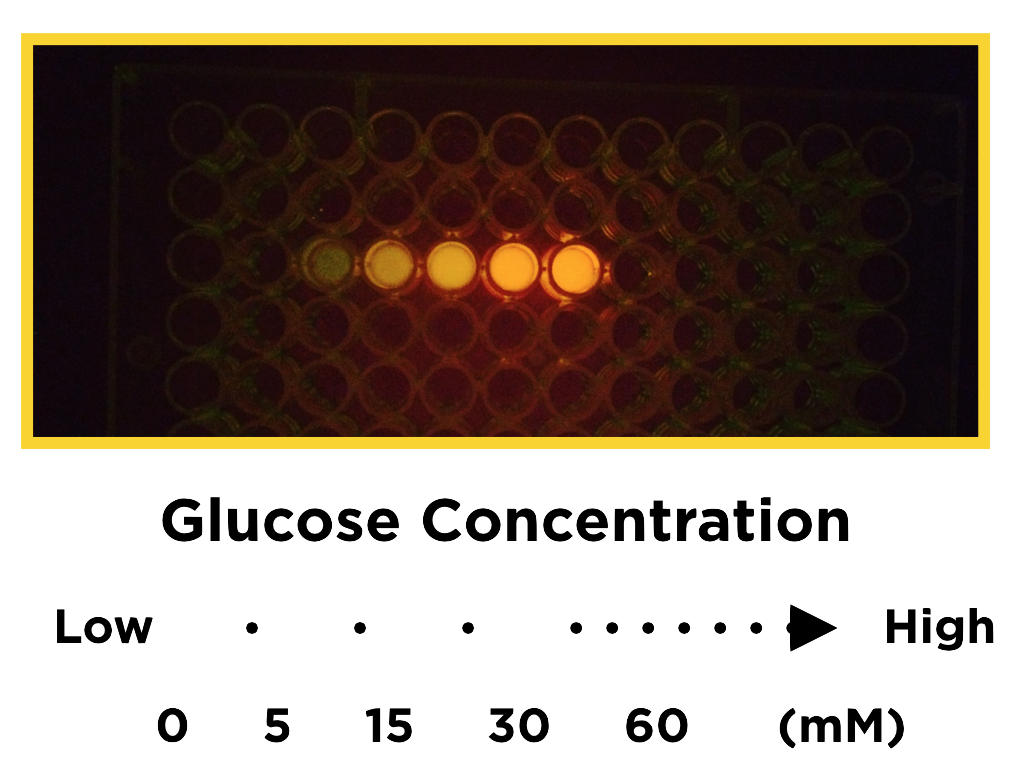
Figure 2: PI_RBS_mRFP_TT transformed in E. coli BL21 (DE3). After 12-hour induction with final glucose concentration of: 0, 5, 15, 30, 60 mM, the fluorescence was observed under excitation ray of 470 nm and with the filter “LEE filter 019”
To further quantify the fluorescent intensity, and simultaneously the growth curve of U. coli, we used final glucose concentration of: 0, 5, 15, 30 mM to induce our U. coli for 8 hours with total volume of 20 ml, and measured the fluorescent intensity at excitation/emission wavelength 562 nm / 599 nm and OD600 for growth curve.
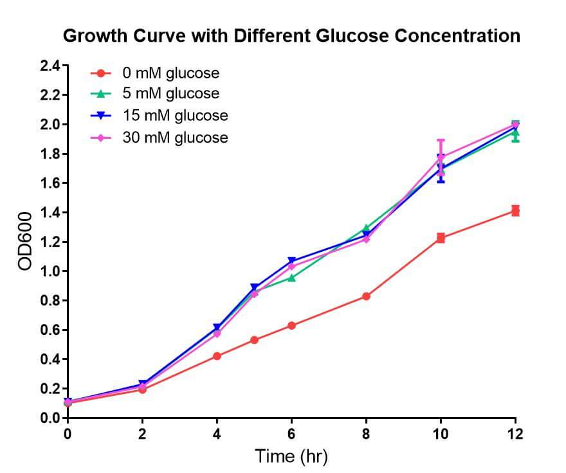
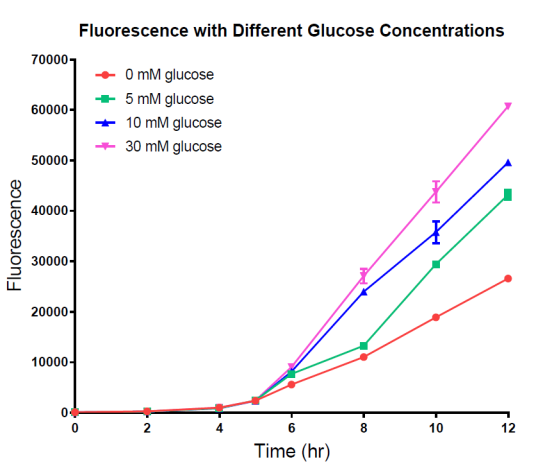
Figure 3: Above is the growth curve and fluorescent intensity, the experiments were done in E. coli BL21-(DE3) in modified M9 medium, the cell were cultured in modified M9 medium for 2 hours and glucose of final concentration: 0, 5, 15, 30 mM were add to induce the expression of mRFP. The fluorescent intensity were measured every 2 hours, after total time exceeds 10 hours, experiments with 5, 15, 30 mM glucose has 2~4 fold significant difference (P<0.05, student t-test)of induction compared to control (0 mM). The presence of glucose also affects the growth curve of our U. coli compared to control, but the growth curves of 5, 15, 30 mM does not show significant difference.
Proof of Concept: Differentiating diabetic urine with normal
To proof that our U. coli serves the purpose to differentiate between diabetic and normal urine samples, we calculated the average prediction interval for the fluorescent intensity in the four different glucose concentrations. The upper control limit is considered as the threshold of “positive”. When the fluorescent intensity in a urine sample surpasses the upper control limit, we can refer to the urine sample as diabetes urine. Furthermore, the diabetic test on U-KNOW has sensitivity: 95% and specificity: 100%.

Figure 4: The 95% prediction interval of glucose positive (5 mM) urine sample (green) and glucose negative (0.1 mM) urine sample (red),the two intervals can be separated after T > 101 mins. To verify the function, by applying the upper limit of the 95% prediction interval of glucose negative urine sample (red) as the “diabetic threshold“, we performed a test to clarify whether our U. coli can differentiate diabetes from control. At time T = 101 mins with n = 84, our result shows sensitivity = 95% / specificity: 100% and if we delay the testing time to T = 120 mins, the sensitivity will be 100% (n=84), which proved that our U. coli could differentiate the diabetic urine from normal urine.
To further elaborate our proof of concept, we have a statistical calculation.
Proof of Concept: Prediction and Quantifying the amount of urine glucose
After successfully differentiating diabetic urine sample with control, we aimed to measure the amount of glucose in urine sample. Thus, we used final glucose concentration of: 0, 1, 3, 5, 15, 30, 45 mM to induce our U. coli for 12 hours in 96 well and measure the fluorescent intensity at excitation/emission wavelength 562 nm / 599 nm, the differences of fluorescent intensity between each group had statistical significance (P<0.05, student t-test) at T (time) = 8hr.
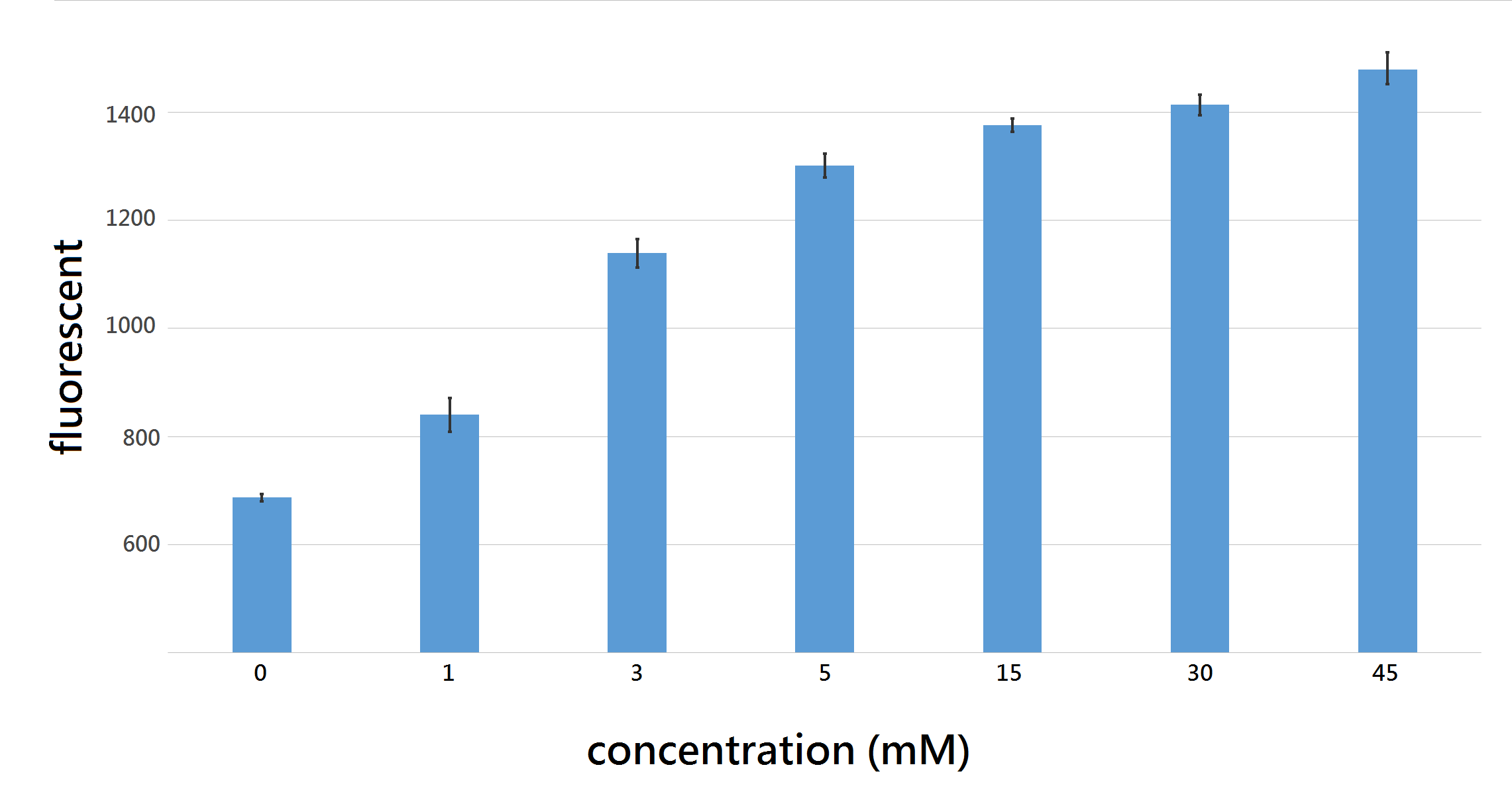
Figure 5: Fluorescence intensity with 95% confidence interval after 8 hour induction with final glucose concentration 0, 1, 3, 5, 15, 30, 45 mM, all differences between each group shows statistical significance (P<0.05, student t-test), proving that out U. coli do differentiate urine sample containing various amount of glucose, ranging from 0~45 mM.
Based on the results above, we derived a prediction formula, to calculate the urine glucose concentration (C)
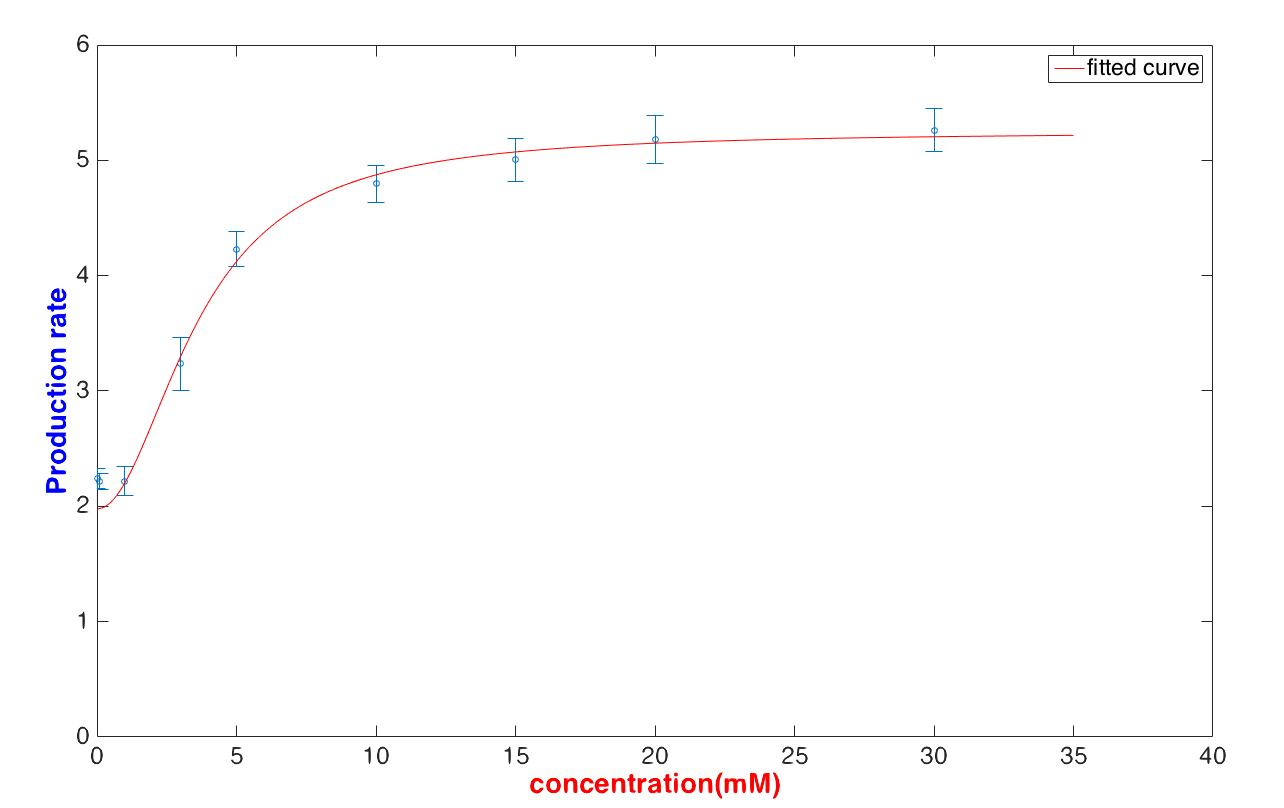
Figure 6: $$\frac{d[GFP]}{dt}=\frac{18.65\times [Glucose]^{2.02}+38.25}{[Glucose]^{2.02}+5.07}$$
To verify the formula, we performed a test to clarify whether our U. coli can predict and quantify the concentration of urine glucose.
Reuslt: with n=63, the average recovery rate is 104% (95% ~114%), which proved that our U. coli do predict and quantify the concentration of urine glucose with good precision.
In conclusion, by applying this prediction formula, it shown that our U. coli could predict and quantify the concentration of urine glucose.
Experiment Design
The goal for our safety circuit is to protect our device user, and it is also an eco-environment tool. When our column-by-column reading device detects arabinose in the sample, the promoter PBAD is activated to lyse and kill the U. coli. Also, the efficacy of the safety circuit can be determined by measuring the growth curve and checking CFU (colony-forming units) assays.
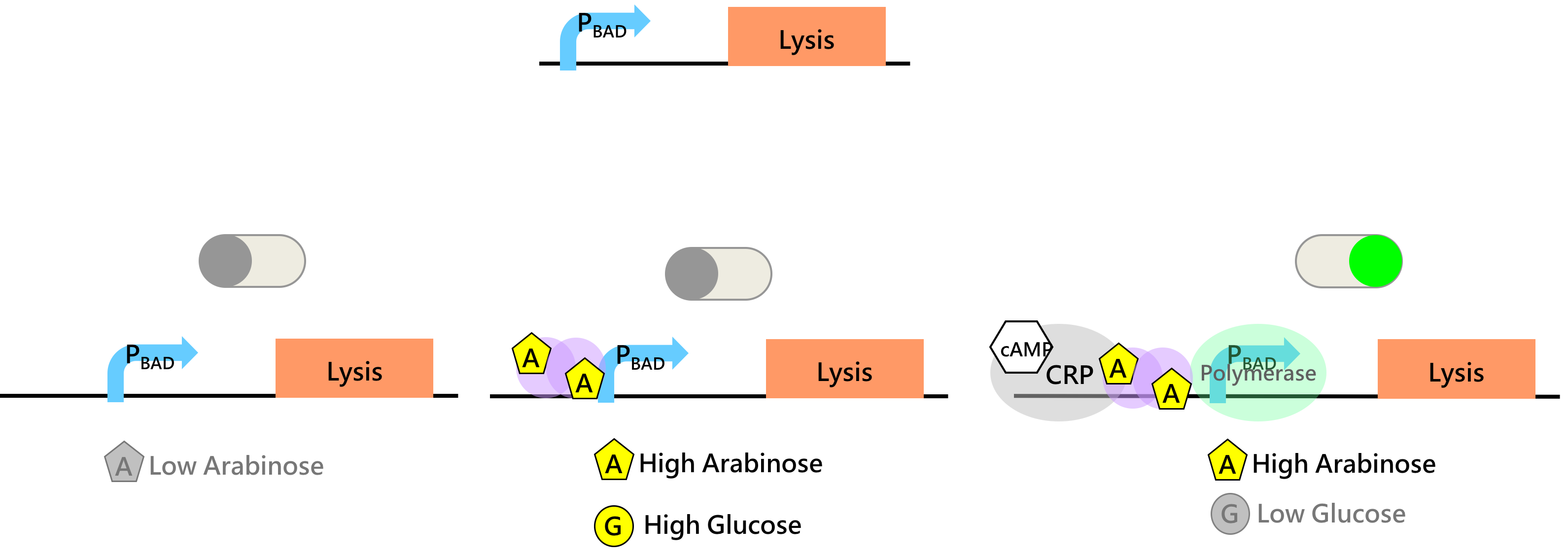
Figure 7: Schematic diagram of PBAD regulation in different concentration of glucose and arabinose.
Growth Inhibition and Lysis activation
Promoter PBAD, is activated by AcaC-arabinose dimers and repressed upon the presence of glucose (Table 1). When the downstream lysis gene is transcribed, the product, lysis proteins, can lyse and kill the U. coli. In the functional test of safety circuit, the growth of U. coli with 3 hour arabinose (10 mM) induction was inhibited, even with presence of glucose (Figure 8). Compared to the control group, arabinose significantly inhibited the growth of U. coli after 50 mins (time T>50 mins). In addition, when glucose and arabinose (10 mM) both present, glucose will repress the growth inhibitory effect of arabinose, making the U. coli continue to growth.
| Activation of PBAD | High Arabinose | Low Arabinose |
|---|---|---|
| High Glucose | Repressed (10 mM Ara) / Active (40 mM Ara) | Repressed |
| Low Glucose | Active | Repressed |
Table 1: Activation of promoter PBAD in different concentration of glucose and arabinose.
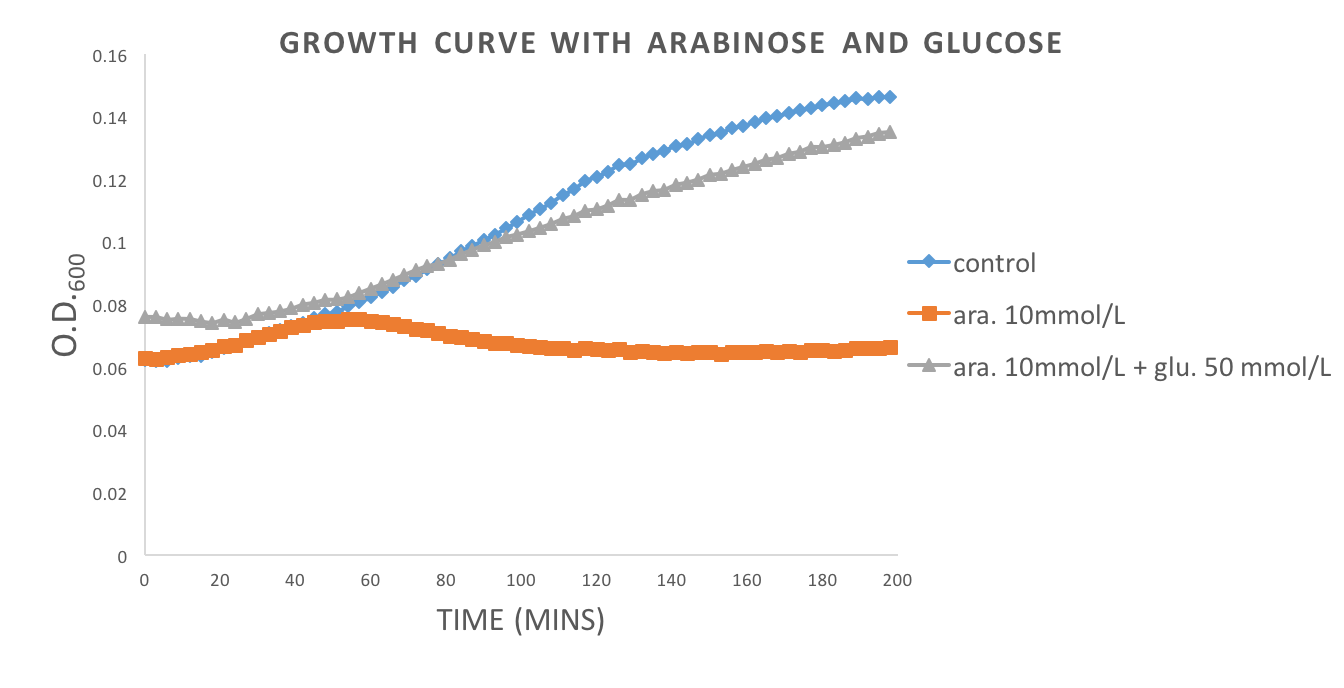
Figure 8: U. coli, PBAD-RBS-lysis-TT transformed in E. coli BL21 (DE3), was incubated for 6 hr and transferred (1%) to modified M9 medium containing different concentrations of arabinose and glucose, and OD600 was measured kinetically by 96-well plate reader.
To understand whether the higher concentration of arabinose represses the glucose-inhibited activation of PBAD, we conducted the functional test. It demonstrated a decrease of the growth of U. coli with 2-hour arabinose (40 mM) induction (Figure 9). Meanwhile, the U. coli with arabinose induction showed considerable low CFUs indicating the induction of lysis gene expression triggers U. coli death (Figure 10).
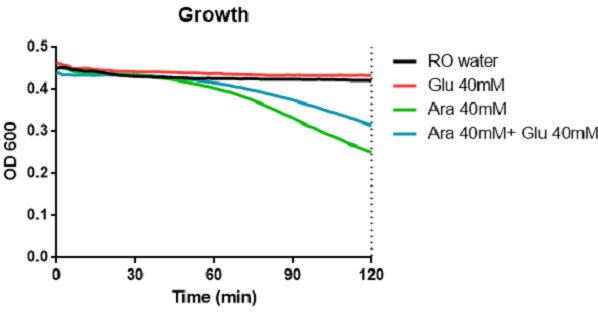
Figure 9: Arabinose inhibited the growth of U. coli. The U. coli was incubated on 96-well plate at 37℃ in the ELISA reader. The signals of OD600 are examined per 3 minutes.
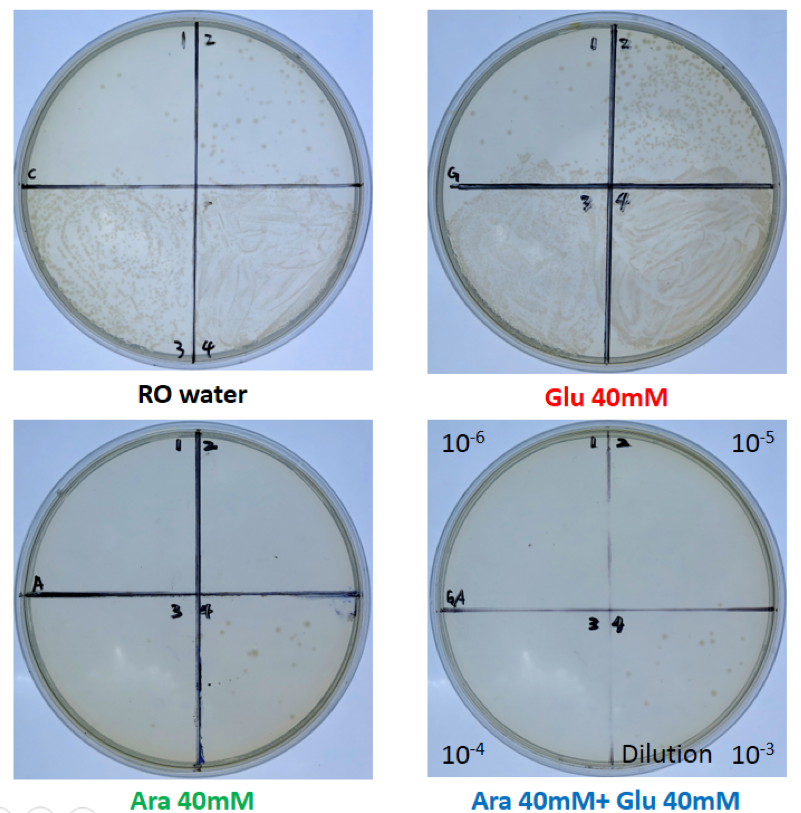
Figure 10: Arabinose triggered the U. coli death. The markers of 4, 3, 2, and 1 in each quarter rounds of plate indicated the dilution of 103, 104, 105, and 106, respectively. Every quarter rounds in plate were plated 20 μl dilutions on LB-Amp plate and counted the CFUs after ~15 hrs of incubation at 37℃. The original cultures were from the Figure 1 experiment at 2 hrs.
These data show that the safety system can work as expected. Arabinose induce expression of the lysis gene (K117000), and then inhibit the E. coli growth and trigger the U. coli death.

